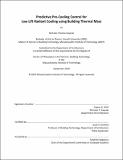Predictive pre-cooling control for low lift radiant cooling using building thermal mass
Author(s)
Gayeski, Nicholas (Nicholas Thomas)
DownloadFull printable version (3.893Mb)
Other Contributors
Massachusetts Institute of Technology. Dept. of Architecture.
Advisor
Leslie K. Norford.
Terms of use
Metadata
Show full item recordAbstract
Low lift cooling systems (LLCS) hold the potential for significant energy savings relative to conventional cooling systems. An LLCS is a cooling system which leverages existing HVAC technologies to provide low energy cooling by operating a chiller at low pressure ratios more of the time. An LLCS combines variable capacity chillers, hydronic distribution, radiant cooling, thermal energy storage and predictive control to achieve lower condensing temperatures, higher evaporating temperatures, and reductions in instantaneous cooling loads by spreading the daily cooling load over time. The LLCS studied in this research is composed of a variable speed chiller and a concrete-core radiant floor, which acts as thermal energy storage. The operation of the chiller is optimized to minimize daily energy consumption while meeting thermal comfort requirements. This is achieved through predictive pre-cooling of the thermally massive concrete floor. The predictive pre-cooling control optimization uses measured data from a test chamber, forecasts of controlled climate conditions and internal loads, empirical models of chiller performance, and data-driven models of the temperature response of the zone being controlled. These data and models are used to determine a near-optimal operational strategy for the chiller over a 24-hour horizon. At each hour, this optimization is updated with measured data from the previous hour and new forecasts for the next 24 hours. The novel contributions of this research include the following: experimental validation of the sensible cooling energy savings of the LLCS relative to a high efficiency split system air conditioner - savings measured in a full size test chamber were 25 percent for a typical summer week in Atlanta subject to standard efficiency internal loads; development of a methodology for incorporating real building thermal mass, chiller performance models, and room temperature response models into a predictive pre-cooling control optimization for LLCS; and detailed experimental data on the performance of a rolling-piston compressor chiller to support this and future research.
Description
Thesis (Ph. D.)--Massachusetts Institute of Technology, Dept. of Architecture, 2010. This electronic version was submitted by the student author. The certified thesis is available in the Institute Archives and Special Collections. Cataloged from student-submitted PDF version of thesis. Includes bibliographical references (p. 143-159).
Date issued
2010Department
Massachusetts Institute of Technology. Department of ArchitecturePublisher
Massachusetts Institute of Technology
Keywords
Architecture.